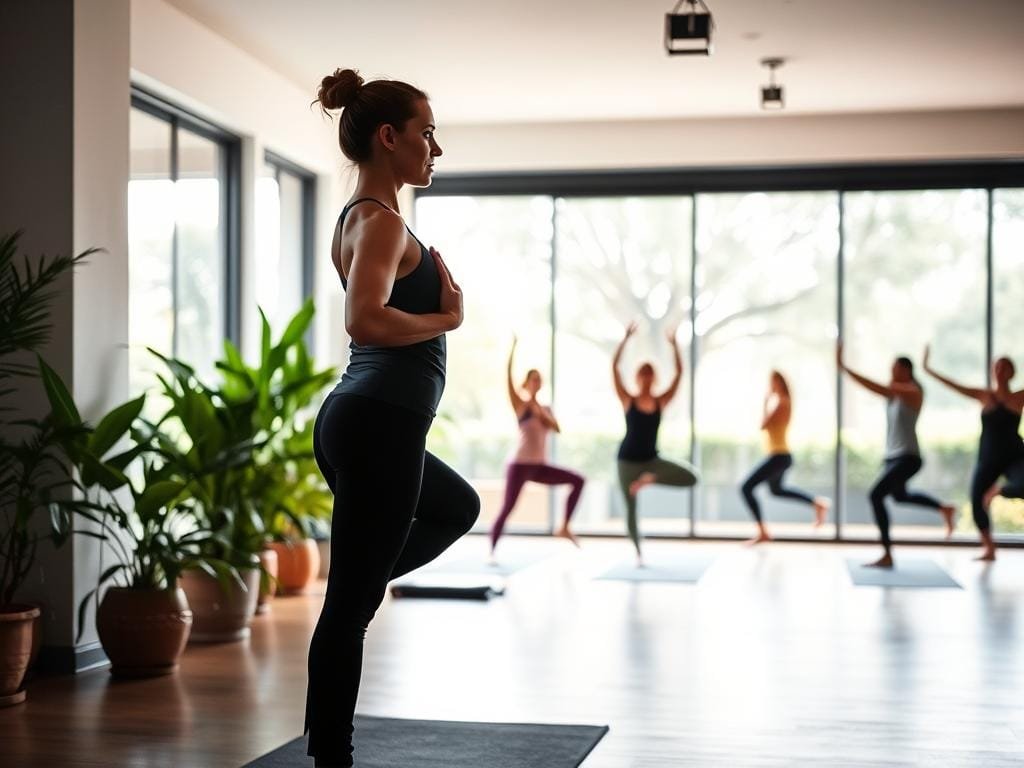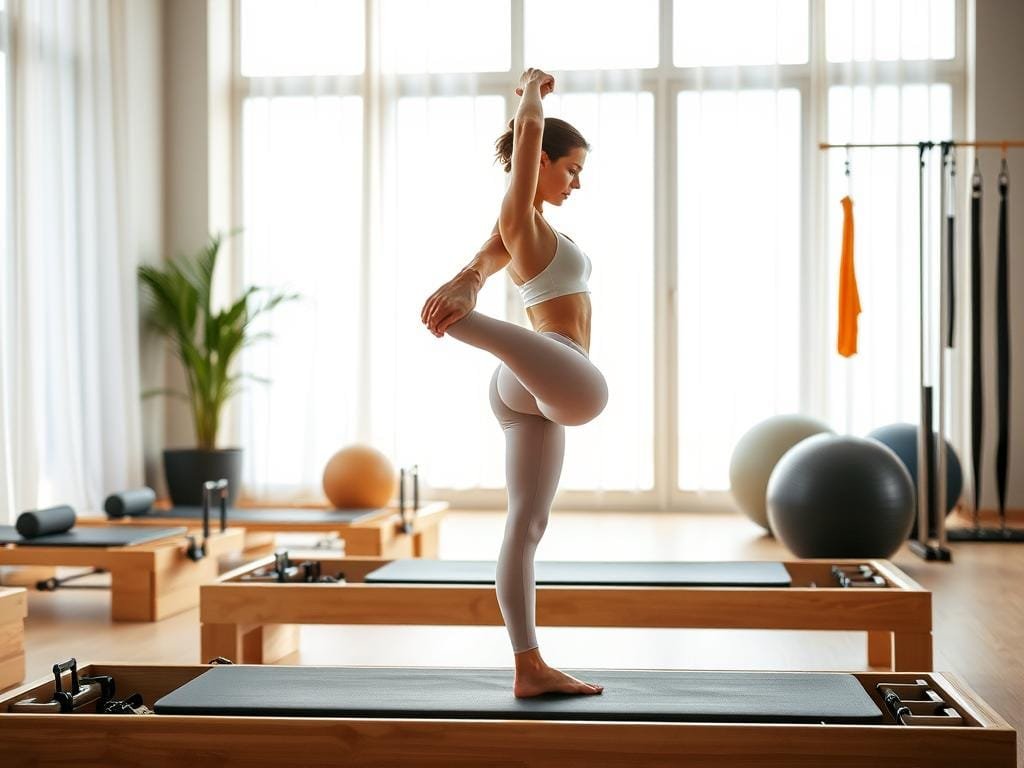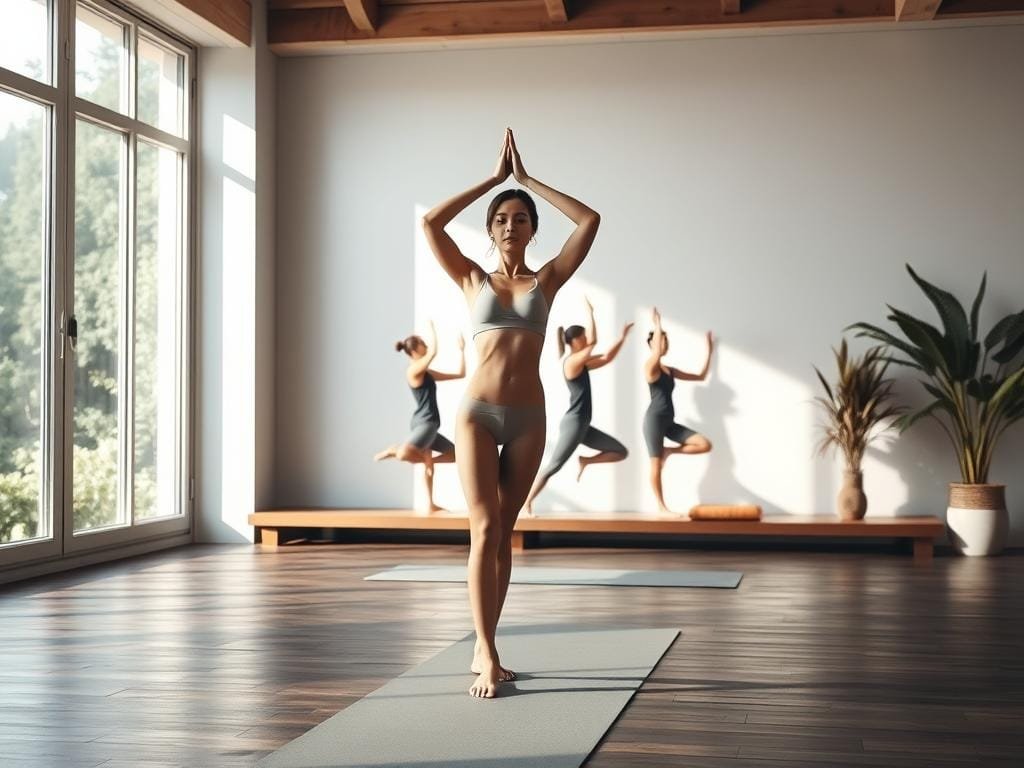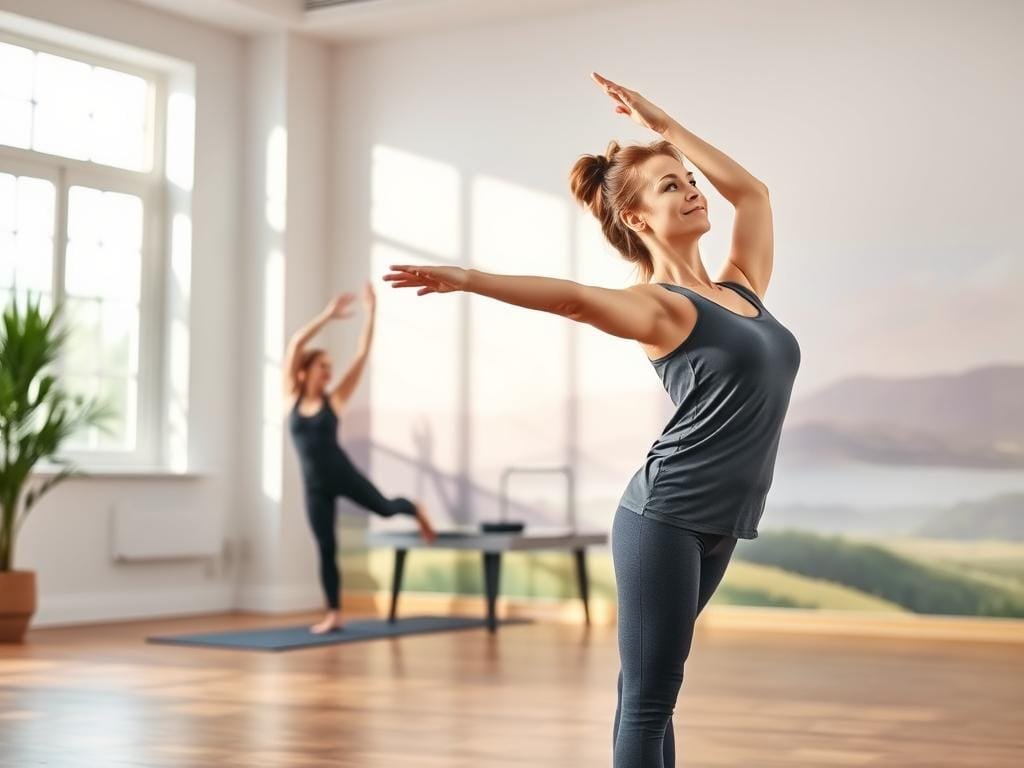Did you know that nearly 75% of Americans experience stress? This can really slow down their fitness journey. Yoga and Pilates are great because they help both your body and mind.
These practices mix physical movements, breathing, and meditation. They help lower stress, make you more flexible, and boost your wellness. Adding yoga and Pilates to your fitness plan can make your life healthier and more balanced.
Table of Contents
Key Takeaways
- Yoga and Pilates enhance the mind-body connection, improving overall fitness.
- These practices reduce stress and improve mental clarity.
- They promote physical health by improving flexibility and strength.
- Holistic fitness through yoga and Pilates leads to a healthier lifestyle.
- Both practices are adaptable for all ages and fitness levels.
The Science of Mind-Body Connection in Holistic Fitness
Exploring the link between your mind and body can unlock your fitness’s full power. The mind-body connection is a complex mix of your brain, nervous system, and body. It affects how you move, handle stress, and recover from workouts.
Neurological Pathways Between Mental and Physical States
The paths that connect your mind and body are complex and go both ways. Doing yoga or Pilates is more than just working out your body. It also changes how your brain works and looks.
Studies show that regular practice can grow brain areas linked to focus, memory, and emotions.
Mindful movement also boosts the brain’s default mode network. This network is key for thinking deeply, reflecting, and daydreaming. It can make you feel clearer and calmer, even when life gets busy.
Research-Backed Benefits of Mindful Movement
Research proves that mindful movement is good for both your body and mind. Some key benefits include:
- Reduced stress and anxiety: Mindful movement can calm your mind and body by activating the parasympathetic nervous system.
- Improved mental clarity and focus: Regular practice boosts your brain’s ability to think clearly and focus.
- Enhanced physical performance: It can also improve how well your muscles and nerves work together, making you better at sports and reducing injury risk.
Adding mindful movement to your fitness routine can bring these benefits to life. It leads to a more balanced and rewarding way to exercise and live well.
Yoga: Ancient Wisdom for Modern Fitness Goals
Yoga offers a complete way to reach your fitness goals today. It combines physical poses, breathing methods, and meditation. This makes yoga a great workout for both your body and mind.

Historical Foundations and Philosophy
Yoga started in India over 5,000 years ago. It comes from Hindu philosophy. It was made to connect the body, mind, and spirit through poses, breathing, and meditation.
Experts say yoga’s old roots help it work well today.
“Yoga is more than just moving your body,” says Nicole Katz, a yoga therapist. “It’s a journey of self-discovery and change.” This idea shows in yoga’s many styles, each with its own benefits.
Different Styles of Yoga for Various Fitness Objectives
There are many yoga styles, like Hatha, Vinyasa, Ashtanga, and Yin. Each style meets different fitness goals. For example, Hatha or Yin yoga helps with flexibility and balance.
If you want a workout that’s dynamic and builds strength, try Vinyasa or Ashtanga yoga. These styles mix movement, strength, and heart rate.
- Hatha Yoga: Focuses on physical postures and breathing techniques for a balanced practice.
- Vinyasa Yoga: Emphasizes flowing movements synchronized with breath for a dynamic workout.
- Ashtanga Yoga: A fast-paced, physically demanding style that builds internal heat and strength.
- Yin Yoga: Targets the deeper tissues of the body, such as connective tissues, for improved flexibility.
Expert Insights: How Yoga Transforms Physical Training
Yoga can make your physical training better by boosting flexibility, strength, and balance. Experts say yoga can also lower injury risk and improve performance. “Yoga with other exercises makes your body stronger and more balanced,” says Nicole Katz.
Knowing yoga’s history, philosophy, and styles helps you use it to reach your fitness goals today.
Pilates Methodology: Core Principles and Modern Applications
Pilates is more than a workout; it’s a complete approach to fitness. Joseph Pilates created it in the early 1900s. It has grown to meet many fitness needs today.

Joseph Pilates and the Evolution of the Practice
Joseph Pilates was a pioneer in fitness. He developed Pilates during World War I to help soldiers recover. His method, called “Contrology,” united body and mind.
Over time, Pilates has evolved to fit modern fitness needs. It keeps its core principles while adding new techniques. Now, it’s a key part of fitness routines around the world.
The Six Fundamental Principles of Pilates
Pilates’ success comes from six key principles: Centering, Concentration, Control, Precision, Breath, and Flow. These ensure each move is done right and safely.
- Centering means using your core to support your body.
- Concentration is about focusing on your movements.
- Control means doing the exercise correctly.
- Precision helps target the right muscles.
- Breath keeps movements smooth.
- Flow is about moving smoothly from one exercise to another.
Mat vs. Reformer: Choosing the Right Approach for Your Goals
Pilates can be done on a mat or with a Reformer machine. Your choice depends on your goals and what you like. Mat Pilates is easy to do anywhere, perfect for home or travel.
Reformer Pilates uses a machine for more resistance. It’s great for those who want a challenge or need support. It’s also good for rehab or if you have physical limitations.
Both mat and Reformer Pilates have their benefits. Mixing both might give you the best workout for your goals.
Physical Transformation Through Mind-Body Practices
Yoga and Pilates connect your mind and body for a physical change. They boost your fitness and help you feel whole.

Developing Flexibility and Functional Range of Motion
Yoga and Pilates make you more flexible and move better. They help you stretch and move in new ways. This makes daily tasks easier and lowers injury risk.
- Improved flexibility boosts athletic performance.
- More range of motion helps your posture and alignment.
- Regular practice makes your movements more efficient.
Building Core Strength and Total-Body Stability
Yoga and Pilates are great for strengthening your core and improving stability. They make you stronger, more balanced, and better at sports and daily tasks.
- Strong core helps keep your posture right.
- Stability from these practices boosts your fitness.
- A strong core also lowers injury risk.
Learn more about the mind-body connection and yoga’s benefits at Brighter Tomorrow Therapy. They talk about how yoga improves your mind and body.
Posture Correction and Alignment Benefits
Yoga and Pilates focus on improving your posture and alignment. They strengthen your spine and improve how you look and feel.
- Good posture lowers back and neck pain risk.
- Proper alignment helps your breathing and movement.
- Correct posture boosts your confidence and presence.
Injury Prevention and Rehabilitation Applications
Yoga and Pilates are also good for preventing injuries and helping with recovery. They strengthen muscles, improve flexibility, and increase body awareness. This helps prevent injuries and aids in recovery.
- Being more aware of your body reduces injury risk.
- Exercises in these practices support recovery.
- Regular practice makes you more resilient and fit.
Mental and Emotional Benefits of Yoga and Pilates
Starting your yoga and Pilates journey can deeply affect your mental and emotional health. These practices are more than just physical workouts. They also boost your mental health and emotional strength.
Stress Reduction and Cortisol Management
Yoga and Pilates are great for reducing stress. They use conscious breathing and mindful movement to lower cortisol levels. A study found that regular yoga can decrease cortisol, helping you feel calm and relaxed.

Enhancing Focus, Concentration, and Mental Clarity
Yoga and Pilates help improve focus and concentration. This can benefit many areas of your life. A wellness expert says, “The discipline in yoga and Pilates boosts cognitive function, helping you perform better at work and in daily tasks.”
Developing Mindfulness in Movement and Daily Life
Mindfulness is a big part of yoga and Pilates. These practices help you become more aware of your thoughts, feelings, and body. This awareness makes you more mindful in daily life, reducing stress and improving well-being.
As you practice mindfulness, you’ll likely feel more present and engaged in your daily activities.
Building Emotional Resilience Through Breath Work
Breath work is key in both yoga and Pilates. Learning different breathing techniques helps build emotional resilience. It helps manage stress and anxiety, leading to a more balanced and resilient you.
A mindfulness expert notes, “Breath work calms the mind and stabilizes emotions.”
Beginner’s Guide to Yoga Practice and Essential Poses
Starting a yoga practice can change your life. It helps with your body, mind, and feelings. First, learn how to set up your space and the basics of yoga.
Setting Up Your Home Practice Space and Essential Equipment
Having a special yoga area at home makes practicing better. You’ll need some key things to begin:
- A good quality yoga mat that provides grip and cushioning
- Comfortable, stretchable clothing
- A quiet, distraction-free area
- Optional props like blocks, straps, and blankets
Choosing a good yoga mat is important. It should be durable and not let you slip.
Foundational Yoga Sequences for Beginners
Start with simple sequences to build a strong base. Here are some poses to begin with:
| Pose | Benefits |
|---|---|
| Mountain Pose (Tadasana) | Improves posture, balance, and stability |
| Downward-Facing Dog (Adho Mukha Svanasana) | Stretches hamstrings, calves, and spine; strengthens arms and shoulders |
| Warrior Pose (Virabhadrasana) | Strengthens legs, hips, and back; improves balance and focus |
These poses can be put together in smooth sequences. They help you get stronger, more flexible, and focused.
Pranayama: Harnessing the Power of Breath
Pranayama, or yogic breathing, is key in yoga. It uses different breathing methods to control energy and calm the mind.
Ujjayi Breathing: This is called the “ocean breath.” You breathe in and out through your nose with a soft hissing sound. It calms your mind and warms your body.
Kapalabhati Breathing: This fast, shallow breathing is great for energy and cleaning your lungs.
Adding pranayama to your practice improves your yoga experience. It brings relaxation, focus, and peace.
Pilates Fundamentals: Step-by-Step Exercise Guide
For newcomers to Pilates, grasping the basics is key for a safe and effective workout. Pilates focuses on building core strength, improving flexibility, and controlling the body. It’s important to set up a space that supports your practice.
Creating an Effective Pilates Practice Environment
First, find a quiet, distraction-free area with a smooth floor. A good mat for Pilates or yoga is a must. You don’t need much equipment to begin. But, as you get better, you might want to try the Reformer or Cadillac.
Make your space distraction-free. Turn off your phone or silence it. Use a mat that won’t slip to avoid accidents. Listening to calming music or nature sounds can also help.
Essential Pilates Exercises for Beginners
Beginners should start with basic exercises. These exercises build core strength, improve flexibility, and enhance body control. Some key exercises include:
- The Hundred: A core-building exercise that involves pumping your arms while engaging your core.
- Roll-Up: An exercise that strengthens your abdominal muscles and improves flexibility.
- Leg Circles: Helps in improving hip mobility and strengthening the lower abdominal muscles.
For a more detailed routine, look into guided Pilates exercises to help you begin.
Mastering the Pilates Breathing Pattern
Pilates stresses the importance of breathing with movement. The breathing pattern in Pilates helps movement flow and makes exercises more effective. You inhale before a movement and exhale during it, focusing on your core.
To get the Pilates breathing right, practice deep, lateral breathing. This means expanding your ribcage sideways, not deeply into your chest or belly. With regular practice, this breathing will become natural, improving your Pilates experience.
Creating Your Integrated Mind-Body Fitness Plan
A good fitness plan mixes physical exercise with mind-body practices. This approach can lead to better results and improved well-being. Adding yoga and Pilates to your routine can enhance your fitness journey.
Designing a Balanced Weekly Schedule
Creating an effective fitness plan starts with a balanced weekly schedule. You need to set aside time for cardio, strength training, and mind-body practices. This balance ensures you work on different fitness aspects without overdoing it.
- Allocate 2-3 days for cardio and strength training
- Incorporate 2-3 days of yoga or Pilates
- Include rest days or active recovery
For more guidance on building a workout plan, you can visit this resource.
Complementing Cardio and Strength Training with Yoga and Pilates
Yoga and Pilates improve flexibility, balance, and core strength. They also aid in recovery and enhance overall performance. These practices complement cardio and strength training well.
Benefits of Combining Different Exercises:
- Improved flexibility and range of motion
- Enhanced core strength and stability
- Better recovery and reduced injury risk
Using Mind-Body Practices for Recovery and Performance Enhancement
Mind-body practices like yoga and Pilates are key for recovery and performance. They help reduce stress and improve focus through deep breathing, meditation, and specific poses.
“The practice of yoga and Pilates can lead to a more balanced and harmonious state of being, enriching both physical and mental well-being.”
Sample 4-Week Plans for Different Fitness Levels
Here are sample 4-week plans for different fitness levels:
| Fitness Level | Week 1-2 | Week 3-4 |
|---|---|---|
| Beginner | 2 days cardio, 2 days yoga | 3 days cardio, 2 days Pilates |
| Intermediate | 3 days strength training, 2 days yoga | 3 days strength training, 2 days Pilates |
| Advanced | 4 days strength and cardio, 1 day yoga | 4 days strength and cardio, 1 day Pilates |
These plans are examples and can be tailored to your preferences and goals.
Finding Quality Instruction in the United States
The United States has many yoga studios and Pilates centers. But not all offer great instruction. Finding a good instructor is key to reaching your fitness goals and staying safe.
Evaluating Yoga Studios and Pilates Centers in Your Area
When looking for a yoga or Pilates studio, think about a few things. This ensures you get quality instruction:
- Location and how easy it is to get there
- The variety of classes and their schedule
- The qualifications and experience of the instructors
- The cleanliness and atmosphere of the studio
- What others say about the studio through reviews and testimonials
Visiting studios in person can give you a good feel of their teaching style and environment.
Credentials to Look for in Qualified Instructors
Good instructors are vital for a safe and effective workout. Look for these credentials:
| Discipline | Certification | Description |
|---|---|---|
| Yoga | RYT (Registered Yoga Teacher) | A recognized yoga alliance certification shows a certain level of training and expertise. |
| Pilates | PMA (Pilates Method Alliance) Certification | This certification means the instructor has gone through rigorous Pilates training. |
Experienced instructors can adjust their teaching to fit their students’ needs. They offer modifications and adjustments as needed.
“A good teacher can make all the difference in your practice. Look for someone who not only knows the techniques but can also communicate them effectively.” –
Online vs. In-Person Learning: Pros and Cons
Online classes have made it easier to find yoga and Pilates instruction. But, both online and in-person learning have their own pros and cons.
Online Learning:
- Pros: It’s convenient, flexible, and you can find many instructors and classes.
- Cons: You miss out on personal feedback, might face technical issues, and need to stay motivated on your own.
In-Person Learning:
- Pros: You get personalized feedback, correction on posture and alignment, and a sense of community.
- Cons: It’s limited by location and schedule, and might be more expensive.
Choosing between online and in-person learning depends on your preferences, schedule, and how you learn best.
By carefully looking at your options and what works for you, you can find quality instruction. This will enhance your mind-body fitness journey.
Conclusion: Embracing the Lifelong Journey of Mind-Body Fitness
Yoga and Pilates are more than just workouts. They are a lifelong journey of growth. They improve your fitness and well-being. By adding mind-body exercises to your routine, you boost your physical health and mental clarity.
Yoga is a dynamic practice that grows with you. It offers various approaches and modifications for every stage of life. For more insights on yoga’s benefits, visit Shvasa’s yoga blog. It explores yoga’s role in personal growth and development.
Embracing this lifelong journey of mind-body fitness helps you thrive at every stage. It fosters a deeper connection to yourself and your community. As you continue, you’ll see the benefits of yoga and Pilates extend beyond the mat, touching every part of your life.

